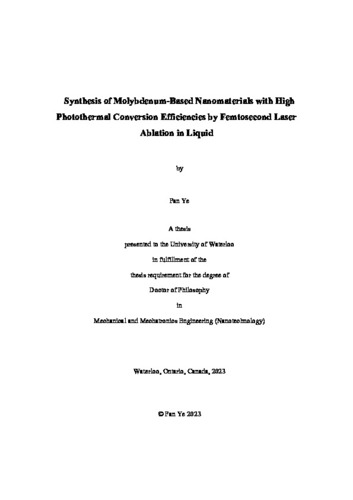| dc.description.abstract | Photothermal therapy is a novel cancer treatment that can be an alternative or useful supplement to traditional cancer treatments. It relies on nanomaterials which target and accumulate in tumor cells to absorb near infrared light and convert the absorbed light energy into heat to kill tumors. Therefore, it is important to prepare nanomaterials with high photothermal conversion efficiencies (PTCEs). Pulsed laser ablation in liquid is a novel technique to prepare nanomaterials. In this work, this technique is used to prepare molybdenum-based nanomaterials including substoichiometric molybdenum oxide (MoO3-X) nanosheets, molybdenum blue (MB) nanorings, and molybdenum selenide (MoSe2) spherical nanoparticles and quantum dots.
MoO3-X and MB nanorings are produced by laser ablation of MoS2 powder and MoO3 powder in water/ethanol mixtures, respectively. The oxidation process of MoS2 and the formation mechanism of MB nanorings are studied. In both ablation processes, ethanol plays a critical role in reducing Mo(VI) which results in the blue color of MoO3-X and MB nanorings. 80-90 vol.% ethanol is the optimum to produce blue-colored MoO3-X, while 30 vol.% ethanol is the optimum to produce MB nanorings with the darkest blue color. A higher concentration of ethanol in the solvent results in the formation of MoO3-X instead of MB. The MoO3-X nanosheets show a high PTCE of 33%, and the MB nanorings show a PTCE as high as 45%.
MoSe2 spherical nanoparticles are produced by laser ablation of MoSe2 powder for a short time (10 min) in isopropyl alcohol or in water containing polyethylene glycol (PEG). The spherical nanoparticles are fragmented from ablated powder particles based on two primary approaches. The first one is thermodynamic equilibrium melting and evaporation which usually occurs when the ablation power is low. The second one is explosive boiling when the ablation power is high. Two kinds of spherical nanoparticles, including polycrystalline nanoparticles and onion-structured nanoparticles, are observed. The polycrystalline nanoparticles are primarily formed by the agglomeration of nanocrystals, atoms and ions ejected from the ablated powder. The onion-structured nanoparticles are formed by nucleation on the surface of melted droplets followed by inward growth of {002} planes of MoSe2 along the radial direction of the droplets layer-by-layer. Additionally, PEGylated MoSe2 nanoparticles can be directly produced by ablating MoSe2 power in aqueous PEG solutions. The surface attachment of PEG to the nanoparticles via Mo-O chemical bonds can suppress oxidation of the nanoparticles. The MoSe2 nanoparticles show high PTCEs of around 38-40% thanks to strong sub-bandgap photon absorption.
Smaller PEGylated MoSe2 quantum dots are synthesized by laser ablation with a high power (1.5 W) for a longer time (30 min). The PTCEs of the PEGylated quantum dots are around 42-44%, higher than that of the PEGylated spherical nanoparticles, which is probably due to a larger absorption cross-section, multiple exciton generation and multiple electron-decay channels. | en |

